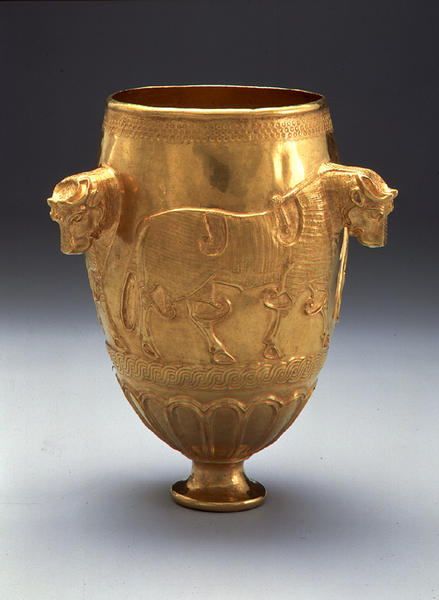Goblet with Bulls
- Northwestern Iran
- 12th - 11th century B.C.
- Gold
- H-16.5 D-9
Catalogue Entry
This stunning goblet, notable for the high quality of its craftsmanship, presents an outstanding synthesis of Iranian and Mesopotamian elements. Supported by a small flaring foot and a rosette-covered base, and bordered at top and bottom by carefully executed guilloches, the main surface of the cup contains a row of three imposing bulls. In contrast to the animals' subtly modeled bodies, worked in low relief and covered with rows of fine decorative linear patterns, their naturalistic heads with curving horns are fully in the round, protruding from the surface of the vessel at right angles. Unlike the vulture heads on the cup in catalogue number 23, these heads are not secured by rivets, but are skillfully cold joined: that is, the metal of the head is worked into the vessel wall on the inside, while the metal of the wall is worked over the necks on the exterior. Both the heads and the bodies have precisely defined cells for inlays in the horns, eyes, ears, and hooves as well as in the curls on the shoulders, legs, and haunches. The roughened surface prepared to receive the adhesive within each cell is clearly visible under magnification.
The goblet finds its place among the many gold and silver vessels unearthed at sites in northern and northwestern Iran, dating to the second through the early first millennium B.C. The closest stylistic counterparts to the stately bulls are seen on a large, gold bowl excavated from Tomb 26 at Marlik in northwestern Iran (fig. 1).1 The Marlik bulls, whose heads are worked in high relief, combine naturalistic representation and decorative surface patterning. These bulls are active, rearing on their hind legs and spreading their wings, in contrast to the placid poses of the bulls on the Shumei goblet, whose measured motion may indicate the artistic influence of objects from Susa in southwestern Iran, such as a bronze beaker with naturalistic bovines and equids calmly pacing along its sides.2 In contrast to vessels recovered from Marlik, an early Iron Age cemetery whose exact dating sequence is still unsettled, the Susa beaker can be dated fairly securely between the twelfth and the tenth century B.C.
The egg-shaped goblet as a form is not Iranian in origin but has a long history in Mesopotamia, where inlaid ostrich-egg containers have come to light from tombs dating to the third millennium B.C. The shape is well documented by glass vessels produced in northern Mesopotamia in the second half of the second millennium B.C., some of which also have the petaled base and small flaring foot of the gold goblet.3 Oval Mesopotamian vessels, made of glass and stone, come from excavations in northwestern Iran at Marlik4 and at Hasanlu.5 These luxurious imports demonstrate the appeal of this shape in Iran and the achievements of the ancient artisans who were inspired by it.
TSK
1. See Negahban 1983, no. G-8, pp. 12-15, 34-36.
2. See Amiet 1966, pp. 472-73; Winter 1980, p. 88, fig. 55.
3. See Harper et al. 1995, pp. 106-8, nos. 69-71, pl. 12.
4. See Negahban 1964, Tomb 45, p. 106.
5. See Pigott 1989, p. 77, fig. 16.
